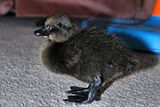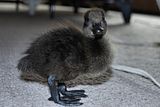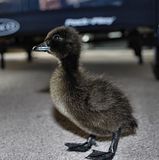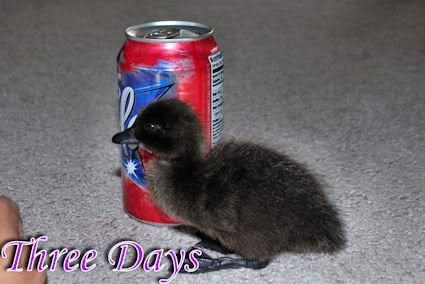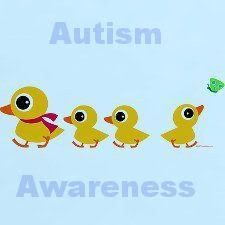Saturday, April 30, 2011
Be Quick to Order
If you plan on diapering your house duck, be quick to order your harnesses. The baby harnesses should be ordered before the baby even arrives. Intermediate harnesses (If using IndoorDucks.com) should probably be ordered at the duckling's arrival. It takes some time for her to make the harnesses and create a batch to be shipped. I just BARELY squeaked my order into the next batch simply because she was kind enough to bend her batch for me. Had she not done that, even though there are still several weeks left until I will need an intermediate harness, Cheyenne would have already grown out of it upon it's arrival if I had to wait for the proceeding batch. So, get that order in. IndoorDucks.com has a chart for ducks that allows you order an adult harness without specific measurements, of you wish, according to breed. I will probably order in advance. You can also wait until your bird is full grown.
Labels:
animals,
diaper,
duckinlg,
ducks,
harness,
home,
house,
indoorducks.com,
indoors,
intermediate,
pet
First Diaper - 11 days old
Cheyenne fits into her first of four baby diapers now. Yesterday, at 11 days old, I fit it to her for the first time. I can't want until she fits into her full grow harness because these little things are less than easy to put on. Her intermediate harness will be on it's way soon. Hopefully that one will be easier, too.
Here are a few pictures of her wearing it yesterday. And, as you can see, she made a leap at gaining more adult-like features. That happened just this week. Amazing how fast they grow.
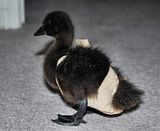
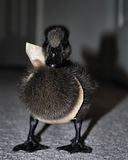
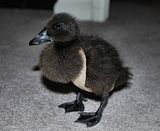
Here are a few pictures of her wearing it yesterday. And, as you can see, she made a leap at gaining more adult-like features. That happened just this week. Amazing how fast they grow.



Thursday, April 28, 2011
Diapered Ducks
I just submitted my order for Cheyenne's intermediate diaper harness from Indoor Ducks !
She won't fit into it for a few weeks, but I want to make sure I have it when she does. She should be fitting into her first of four baby harnesses from The Goose's Mother by the end of this week. She will be two weeks old.
We had so much fun together yesterday. She's getting stronger every day. She is becoming a little more accustomed to cooler temps (slowly but surely) and that means longer play time out of her 'nest'. She's gaining more confidence and is starting to wander further and further from my side with each day. It's nice to see her relax more and have fun without being so concerned about where I am. She's starting to understand that even though she doesn't physically see me, I'm still with her. She starts off every play session with a swim, preens and checks things out around the house, swims again, and if she's not too cold, settles on my lap for a nice, long nap. She's 10 days old today.
She won't fit into it for a few weeks, but I want to make sure I have it when she does. She should be fitting into her first of four baby harnesses from The Goose's Mother by the end of this week. She will be two weeks old.
We had so much fun together yesterday. She's getting stronger every day. She is becoming a little more accustomed to cooler temps (slowly but surely) and that means longer play time out of her 'nest'. She's gaining more confidence and is starting to wander further and further from my side with each day. It's nice to see her relax more and have fun without being so concerned about where I am. She's starting to understand that even though she doesn't physically see me, I'm still with her. She starts off every play session with a swim, preens and checks things out around the house, swims again, and if she's not too cold, settles on my lap for a nice, long nap. She's 10 days old today.
Tuesday, April 26, 2011
No-Slip Bath
I LOVE using a paint tray for their first baths. It's low to the ground, not so deep that they can easily drown while we wait on their feathers, and there is a ramp for them to walk up when they don't want to submerge themselves. I was a bit concerned at how slippery it was, though. Even though it isn't deep, it seems to be a natural reaction for Cheyenne to try and paddle. It looked a little rough on her legs when they would slip out from under her.
So, I added Easy Liner non-adhesive grip mat to the bottom. This is the same stuff I use in her cage on top of a towel to prevent splayed legs, get water runoff, and make cleaning much easier. I had to attach it with velcro strips because it floats in the water and I also needed the option to remove it for cleaning.
Like I said in the last post, Easy Liner makes your life easier! Get some :)

So, I added Easy Liner non-adhesive grip mat to the bottom. This is the same stuff I use in her cage on top of a towel to prevent splayed legs, get water runoff, and make cleaning much easier. I had to attach it with velcro strips because it floats in the water and I also needed the option to remove it for cleaning.
Like I said in the last post, Easy Liner makes your life easier! Get some :)

Day 8 Update
I can't wait until Cheyenne can withstand cooler temps. The heat has been cranked up in the house, all the windows have been shut, and I've been sleeping under her heat lamp for eight days. lol She's well worth it, of course, and I certainly signed up for it :) The reason I'm most anxious to get her off the lamp is because I have to cut our play time together short before she chills. Swim time, especially. If she's in her "nest" under the lamp or with her heat pad in the play pen and I have to leave the room for a second, she lets me know she isn't happy! In the next couple weeks, I'll finally be able to let HER decide where she wants to go. I power a blow dryer on low after she bathes, though, and let her decide how far to sit from it while she preens to warm up her feet. That seems to help.
I started giving her free-choice grit (no oyster shell) on day 4. Something told me to wait until she darn well knew her mash was her feed and not the grit. I was just worried she would confuse the two if I introduced it too early. Maybe I'm too paranoid. She's doing well with it and rarely picks at it. I bought a ten pound bag and I'll probably have left overs in 100 years from now!
Let me tell you, she is a pooping machine! It's astounding. If you bring your hatchling home and think, "Hey! That's not bad at all.... they barely mess their cage", think again. Once that feed starts flowing and once they start growing, they poop and they poop a lot! I highly recommend having a large supply of rags and towels ready for your duckling. I use them for everything. You will be washing their 'bedding' often and will need replacements while it's in the dryer. You will want to place a towel or two around their 'mini pond'. If you aren't diapering now or ever, you will need a towel on your lap, and you will want rags to pick up any 'accidents'. Taking the advice of The Goose's Mother, I use Easy Liner layed-out on top of a towel in their 'nest'. Trust me, it will make your life easier.
She's eating a lot more. By the end of the week, I'll have to upgrade from the egg poacher to a cat dish, which she's now big enough to eat out of.
That's about it for now :)
I started giving her free-choice grit (no oyster shell) on day 4. Something told me to wait until she darn well knew her mash was her feed and not the grit. I was just worried she would confuse the two if I introduced it too early. Maybe I'm too paranoid. She's doing well with it and rarely picks at it. I bought a ten pound bag and I'll probably have left overs in 100 years from now!
Let me tell you, she is a pooping machine! It's astounding. If you bring your hatchling home and think, "Hey! That's not bad at all.... they barely mess their cage", think again. Once that feed starts flowing and once they start growing, they poop and they poop a lot! I highly recommend having a large supply of rags and towels ready for your duckling. I use them for everything. You will be washing their 'bedding' often and will need replacements while it's in the dryer. You will want to place a towel or two around their 'mini pond'. If you aren't diapering now or ever, you will need a towel on your lap, and you will want rags to pick up any 'accidents'. Taking the advice of The Goose's Mother, I use Easy Liner layed-out on top of a towel in their 'nest'. Trust me, it will make your life easier.
She's eating a lot more. By the end of the week, I'll have to upgrade from the egg poacher to a cat dish, which she's now big enough to eat out of.
That's about it for now :)
Monday, April 25, 2011
Sunday, April 24, 2011
Friday, April 22, 2011
Cayuga
What is a Cayuga Duck?
From Wikipedia, the free encyclopedia
Cayuga Duck
A Cayuga Duck is a breed of domesticated duck used for egg and meat production as well as an ornamental bird. The Cayuga name is taken from Cayuga Lake , one of the lakes in the Finger Lakes chain, in New York State where the breed was popularized. The traditional story for the development of this breed is that a miller in Dutchess County captured two wild black ducks and used pinioning to keep them at his pond. The offspring of this pair was prized for flavorful meat and breeding efficiency.[1]
The Cayuga breed is in the Medium class and has been a recognized breed of the American Poultry Association since 1874. the standard weight for adult males is 8 pounds and females 7 pounds. The Cayuga are characterized by a black bill and black plumage which is an iridescent beetle green in the correct light. In breeding an emphasis is put on correct coloration, carriage and a large breast. The Cayuga duck has dark brown eyes, black shanks and toes, except in old drakes where some orange shading may appear. Ducklings have black plumage. For exhibition presence of white color in the outer plumage is a disqualification. It is also well liked by many as a great yard pet as they tend to stay close to home.
For those who wish to keep ducks, but live close to others that would make keeping the Pekin breed impractical because of the loud quack, The Cayuga duck may be an alternative as its quack is not as loud or frequent as the Pekin. The temperament of the Cayuga is docile.
Adult Cayuga Ducks enjoy eating snails, slugs, and most other insects.
The Cayuga duck will more often sit on and hatch her eggs than other domestic breeds of duck. Incubation for the eggs is 28 days. When using an incubator the temperature should be 99.5 °F at 86% humidity for days 1-25, and 98.5 °F at 94% humidity for days 26-28.
This breed of duck is listed as threatened by the American Livestock Breeds Conservancy. [2]
http://en.wikipedia.org/wiki/Cayuga_Duck
Click Here For More Cayuga Duck Photos on Flickr.com
From Wikipedia, the free encyclopedia
Cayuga Duck
A Cayuga Duck is a breed of domesticated duck used for egg and meat production as well as an ornamental bird. The Cayuga name is taken from Cayuga Lake , one of the lakes in the Finger Lakes chain, in New York State where the breed was popularized. The traditional story for the development of this breed is that a miller in Dutchess County captured two wild black ducks and used pinioning to keep them at his pond. The offspring of this pair was prized for flavorful meat and breeding efficiency.[1]
The Cayuga breed is in the Medium class and has been a recognized breed of the American Poultry Association since 1874. the standard weight for adult males is 8 pounds and females 7 pounds. The Cayuga are characterized by a black bill and black plumage which is an iridescent beetle green in the correct light. In breeding an emphasis is put on correct coloration, carriage and a large breast. The Cayuga duck has dark brown eyes, black shanks and toes, except in old drakes where some orange shading may appear. Ducklings have black plumage. For exhibition presence of white color in the outer plumage is a disqualification. It is also well liked by many as a great yard pet as they tend to stay close to home.
For those who wish to keep ducks, but live close to others that would make keeping the Pekin breed impractical because of the loud quack, The Cayuga duck may be an alternative as its quack is not as loud or frequent as the Pekin. The temperament of the Cayuga is docile.
Adult Cayuga Ducks enjoy eating snails, slugs, and most other insects.
The Cayuga duck will more often sit on and hatch her eggs than other domestic breeds of duck. Incubation for the eggs is 28 days. When using an incubator the temperature should be 99.5 °F at 86% humidity for days 1-25, and 98.5 °F at 94% humidity for days 26-28.
This breed of duck is listed as threatened by the American Livestock Breeds Conservancy. [2]
http://en.wikipedia.org/wiki/Cayuga_Duck
Click Here For More Cayuga Duck Photos on Flickr.com
Thursday, April 21, 2011
Wednesday, April 20, 2011
Do Your Research
I thought I would make a quick post on how important it is to steer far from impulse buys, do your research, and be fully prepared before you take in your duckling.
Everything from behavior to nutrition to housing requirements should be known to the best of your ability. Confidence in your ability to take care of this animal of prey goes a long way and is key to your success as a companion and your duckling's ability to thrive and be happy. When someone tells you taking in a bird is a commitment, don't take it for granted. A duck relies on its flock and wings for survival. Since most domesticated ducks haven't the ability to fly, that leave us. Ducklings, especially, get extremely upset when they are without you. In the wild, if mom isn't around, it's likely the death of him/her. After taking in a duckling, you must respect that they are a prey animal. . The way they imprint on us is no joke. If you have the slightest feeling that the excitement of getting a duckling will wear off, or that you simply won't have enough time for him/her in the future, then getting a house duck probably isn't for you. We made the decision to bring them into our lives.... we owe it to them to abide by that commitment and truly BE be their life-long companion. Having everything prepared far ahead of time, and being armed with knowledge to care for Cheyenne has made all the difference in making this a pleasant experience for the both of us.
A wealth of information can be found in the Files link and threads at Pet Ducks R Us and on various hatchery blogs.
Happy Researching!
( ')>
Everything from behavior to nutrition to housing requirements should be known to the best of your ability. Confidence in your ability to take care of this animal of prey goes a long way and is key to your success as a companion and your duckling's ability to thrive and be happy. When someone tells you taking in a bird is a commitment, don't take it for granted. A duck relies on its flock and wings for survival. Since most domesticated ducks haven't the ability to fly, that leave us. Ducklings, especially, get extremely upset when they are without you. In the wild, if mom isn't around, it's likely the death of him/her. After taking in a duckling, you must respect that they are a prey animal. . The way they imprint on us is no joke. If you have the slightest feeling that the excitement of getting a duckling will wear off, or that you simply won't have enough time for him/her in the future, then getting a house duck probably isn't for you. We made the decision to bring them into our lives.... we owe it to them to abide by that commitment and truly BE be their life-long companion. Having everything prepared far ahead of time, and being armed with knowledge to care for Cheyenne has made all the difference in making this a pleasant experience for the both of us.
A wealth of information can be found in the Files link and threads at Pet Ducks R Us and on various hatchery blogs.
Happy Researching!
( ')>
All Settled In
I was too busy to update yesterday, but we picked the baby up :) It was a long drive on curvy roads, but well worth it. I had ordered a drake, but when the owner brought the duckling out, they had set a female aside. He left the office to see if he had a drake left. He came back and said the sexed Cayugas had been shipped off, but grabbed a black duckling from a mixed straight run batch. He said it may not be a Cayuga and could very well be a black Runner. I have an untrained eye, of course, but by the looks of it's conformation, it certainly looked like a runner to me! I'm not the biggest fan of runners, and told him I would be more than happy to take the girl. It is better this way, I'm sure. The only reason I originally wanted a male, really, was because they are quieter than females. I think having a female, though, will make breeding season and introducing another duck later much easier.
So, I want to introduce you to Cheyenne :) She has taken to home quite well. In the truck, I took her from her box and let her get to know my voice and face for a couple minutes, and placed her back. Brought her back out after that, and I was already Mom. She quieted down and fell asleep immediately in my hands. She would wake up to look at me and make sure I was still with her from time to time and back to sleep she went. When she was in her box, I had a hand/body warmer underneath it to generate some heat for her during the drive.
She's very happy with her safe place (her cage), and so am I. The wheels on the bottom of the cage have made this experience so much easier on the both of us. I can take her into any room with me so easily. And, last night, after wheeling her cage next to my bed, I was surprised to have gotten the best night's sleep I've had in a long time! She just curled up closest to my head she could get, preened for a while, and slept all night.
We've made just three adjustments to the set-up pictured in a previous post:
The red poultry feeder won't do for now. Neither would the duckling dish I ordered from http://www.thegoosesmother.com/ (too deep; not the one pictured), so I am using a microwave egg poacher cut in half. It works perfect for her current size and doesn't tip over.
She's not interested in the duck stuffed animal, so I added another towel under the lamp to curl up to, and I also added a safety net of sorts under the lamp so there is absolutely no way for the lamp to fall inside the cage.
Cheyenne has needed some reprimand with biting my face moles. LOL!!! I hear they are good at learning words, so I'm vocally reprimanding her and blowing on her quickly to make her stop. It hurts already, so we definitely don't want this being a problem as she gets older and stronger!
If anyone is interested in getting the cage I use, you can get the Critter Nation Cage Here. You can buy either a single or a double unit. I have a double unit, but removed the top. No tools are needed to put it together or take it apart, so that's really nice. A single unit is big enough for a duck to continue using it full grown. Since the cage is open (unlike an aquarium, etc), it's important to keep the duckling away from drafts and air conditioning for the first couple weeks. The heat source the lamp produces also escapes just as easy, so make sure your baby is plenty warm enough.
With that, I'll leave you with pictures. I'll be updating often :)
Meet Cheyenne (2 days old):
click image to make larger
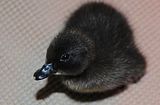
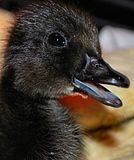
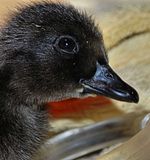
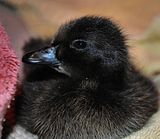

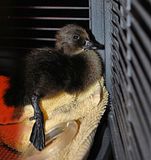
So, I want to introduce you to Cheyenne :) She has taken to home quite well. In the truck, I took her from her box and let her get to know my voice and face for a couple minutes, and placed her back. Brought her back out after that, and I was already Mom. She quieted down and fell asleep immediately in my hands. She would wake up to look at me and make sure I was still with her from time to time and back to sleep she went. When she was in her box, I had a hand/body warmer underneath it to generate some heat for her during the drive.
She's very happy with her safe place (her cage), and so am I. The wheels on the bottom of the cage have made this experience so much easier on the both of us. I can take her into any room with me so easily. And, last night, after wheeling her cage next to my bed, I was surprised to have gotten the best night's sleep I've had in a long time! She just curled up closest to my head she could get, preened for a while, and slept all night.
We've made just three adjustments to the set-up pictured in a previous post:
The red poultry feeder won't do for now. Neither would the duckling dish I ordered from http://www.thegoosesmother.com/ (too deep; not the one pictured), so I am using a microwave egg poacher cut in half. It works perfect for her current size and doesn't tip over.
She's not interested in the duck stuffed animal, so I added another towel under the lamp to curl up to, and I also added a safety net of sorts under the lamp so there is absolutely no way for the lamp to fall inside the cage.
Cheyenne has needed some reprimand with biting my face moles. LOL!!! I hear they are good at learning words, so I'm vocally reprimanding her and blowing on her quickly to make her stop. It hurts already, so we definitely don't want this being a problem as she gets older and stronger!
If anyone is interested in getting the cage I use, you can get the Critter Nation Cage Here. You can buy either a single or a double unit. I have a double unit, but removed the top. No tools are needed to put it together or take it apart, so that's really nice. A single unit is big enough for a duck to continue using it full grown. Since the cage is open (unlike an aquarium, etc), it's important to keep the duckling away from drafts and air conditioning for the first couple weeks. The heat source the lamp produces also escapes just as easy, so make sure your baby is plenty warm enough.
With that, I'll leave you with pictures. I'll be updating often :)
Meet Cheyenne (2 days old):
click image to make larger






Tuesday, April 19, 2011
It's About That Time
We're leaving in an hour to pick up Yoshi! I'm so excited... and a little nervous. 4am wake-up, and now I'm drowning myself in coffee. Today is the start of a big commitment.
Monday, April 18, 2011
Hatch Day! ( ')>
It's hatch day! I'm so excited. We're waking up bright and early in the morning to pick the little guy up at Metzer Farms in California. It's about a 2.5 hour drive. I'm sure last night was my last full night of sleep for a little while! :D Really looking forward to going. I'm thankful for the opportunity to pick him up in person just hours after he hatches. The wait seemed like forever. Today is full of housework and making sure everything is picked up and taken care of so I can focus on him.
Lots and lots of pictures and updates to come :)
This will be his "safe place". It's large enough so that he can still use it when he is full grown. It can be disassembled/reassembled easily and it's on wheels, so very portable. (has a top, too)
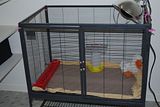
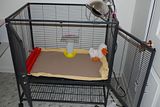
Lots and lots of pictures and updates to come :)
This will be his "safe place". It's large enough so that he can still use it when he is full grown. It can be disassembled/reassembled easily and it's on wheels, so very portable. (has a top, too)


Subscribe to:
Posts (Atom)



